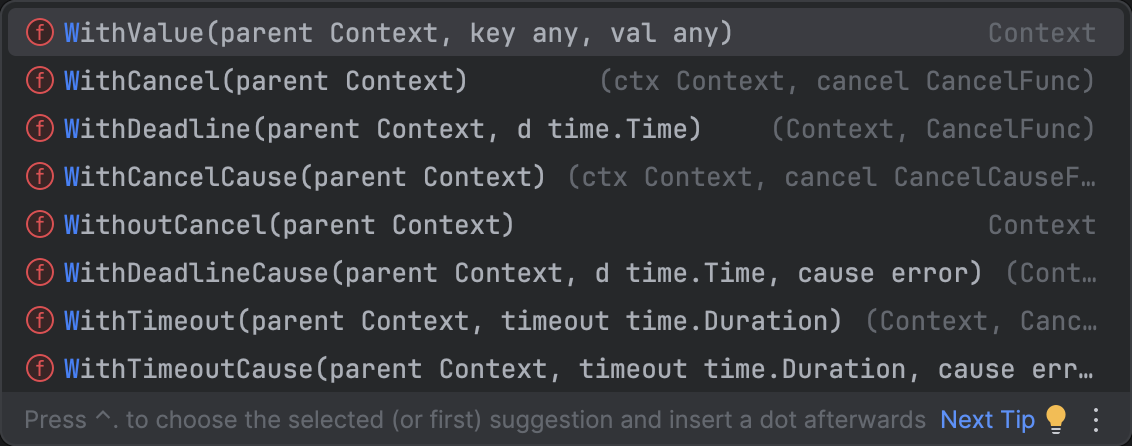Golang
1.数据结构
1.1 数组和切片的区别
| 区别项 | 数组 | slice |
|---|---|---|
| 长度和容量 | 长度固定,创建后不可更改 | 长度不固定,可以动态改变大小,其容量基于底层数组的大小 |
| 内存分配 | 声明时一次性分配足够的内存 | |
| 赋值和传递 | 数组赋值或作为函数传递时,会拷贝整个数组 | slice 仅传递切片的结构,不改变指向的底层数组 |
| 扩容 | 不会扩容 | 支持扩容 |
对于数组
[3]int,其类型和长度都是维护在类型信息中,不需要像slice有一个结构体去维护长度 和 元素类型 信息。因此[2]int和[3]int是不同的类型。
slice 结构体如下:
type slice struct {
array unsafe.Pointer // 存储的是底层数组的指针
len int
cap int
}当 slice 发生扩容时会发生:
- 新数组分配:如果当前切片的容量(cap)不足以容纳新增的元素,
Go会创建一个新的更大的底层数组; - 元素复制:
Go会将当前切片引用的底层数组中的元素复制到新分配的数组中; - 指针更新:切片的指针会更新为新数组的地址,原有的底层数组如果没有其他引用,将会被垃圾回收。
1.2 谈一下 rune 类型
先看下 rune 在源码中长什么样子。
// rune is an alias for int32 and is equivalent to int32 in all ways. It is
// used, by convention, to distinguish character values from integer values.
type rune = int32翻译下英文:
Rune是int32的别名,在所有方面都等同于int32。按照惯例,它被用来区分字符值和整数值。
rune 主要用来表示一个 Unicode 码点,在 UTF-8 编码规则下可能对应 1~4 个 byte。
func main() {
func main() {
var s = "go算法"
fmt.Println(len(s)) // 长度为 8,g 和 o 分别占用一个长度,算 和 法 分别占用一个长度
fmt.Println(len([]rune(s))) // 长度为 4,因为rune是把 算 和 法 当成一个字符整体去统计的
for _, v := range s {
fmt.Println(v) // 103对应`g`、111对应`o`、31639对应`算`、27861对应`法`
}
}2.语言基础
2.1 函数调用时的参数传递是值传递还是引用传递?
go 语言中只有值传递。这意味着当一个函数接受一个参数时,它会接收到原始值的一个副本。
非引用类型:int、string、struct 等
func main() {
var num int = 8
fmt.Printf("原始参数地址:%p\n", &num) // 0xc00001c0a8
printNum(num)
}
func printNum(n int) {
fmt.Printf("函数接收的参数地址:%p\n", &n) // 0xc00001c0d0
}printNum 函数时,将实参 8 传递给函数的形参 n 时,是将值 8 拷贝了一份,num 和 n 自己的地址 和 地址指向的值 都是独立的一份。引用类型:指针、map、slice、chan
func main() {
var num int = 8
fmt.Printf("原始参数地址:%p\n", &num) // 0xc00001c0a8
printNum(&num)
}
func printNum(n *int) {
fmt.Printf("函数接收的参数地址:%p\n", &n) // 0xc00000a030
fmt.Println(n) // 0xc00001c0a8
}0xc00000a030,且 n 的值是 0xc00001c0a8。0xc00001c0a8 指向的是 num 的值 8。总结来说,
Go语言在形式上是值传递,但对于引用类型,由于传递的是对底层数据结构的引用(或者说指针),在实际效果上类似于某些其他语言中的引用传递。
3.关键字
3.1 defer
结构体
// A _defer holds an entry on the list of deferred calls.
// If you add a field here, add code to clear it in deferProcStack.
// This struct must match the code in cmd/compile/internal/ssagen/ssa.go:deferstruct
// and cmd/compile/internal/ssagen/ssa.go:(*state).call.
// Some defers will be allocated on the stack and some on the heap.
// All defers are logically part of the stack, so write barriers to
// initialize them are not required. All defers must be manually scanned,
// and for heap defers, marked.
type _defer struct {
started bool
heap bool
// openDefer indicates that this _defer is for a frame with open-coded
// defers. We have only one defer record for the entire frame (which may
// currently have 0, 1, or more defers active).
openDefer bool
sp uintptr // sp at time of defer
pc uintptr // pc at time of defer
fn func() // can be nil for open-coded defers
_panic *_panic // panic that is running defer
link *_defer // next defer on G; can point to either heap or stack!
// If openDefer is true, the fields below record values about the stack
// frame and associated function that has the open-coded defer(s). sp
// above will be the sp for the frame, and pc will be address of the
// deferreturn call in the function.
fd unsafe.Pointer // funcdata for the function associated with the frame
varp uintptr // value of varp for the stack frame
// framepc is the current pc associated with the stack frame. Together,
// with sp above (which is the sp associated with the stack frame),
// framepc/sp can be used as pc/sp pair to continue a stack trace via
// gentraceback().
framepc uintptr
}defer后面跟的必须是函数或者方法调用,defer后面的表达式不能加括号;- 被
defer的函数或方法的参数的值在定义defer语句的时候就被确定下来了; - 被
defer的函数或者方法如果存在多级调用,只有最后一个函数或方法会被defer到函数return或者panic之前执行; - 被
defer的函数执行顺序满足LIFO原则,后defer的先执行; - 被
defer的函数可以对defer语句所在的函数的命名返回值做读取和修改操作;
4.并发编程
4.1 聊一下 channel
4.2 聊一下 context
Context 的结构体
// Context's methods may be called by multiple goroutines simultaneously.
type Context interface {
// Deadline returns the time when work done on behalf of this context
// should be canceled. Deadline returns ok==false when no deadline is
// set. Successive calls to Deadline return the same results.
Deadline() (deadline time.Time, ok bool)
Done() <-chan struct{}
// If Done is not yet closed, Err returns nil.
// If Done is closed, Err returns a non-nil error explaining why:
// Canceled if the context was canceled
// or DeadlineExceeded if the context's deadline passed.
// After Err returns a non-nil error, successive calls to Err return the same error.
Err() error
Value(key any) any
}
Context 设计原理
在 Goroutine 构成的树形结构中对信号进行同步以减少计算资源的浪费是 context.Context 的最大作用。



在 Go 语言中,context.Context 对象设计的目的之一就是在并发环境下进行高效的请求取消通知、超时控制及携带请求级上下文信息。 之所以需要在多个 goroutine 中传递 context.Context,主要有以下几个原因:
取消通知(Cancellation Signal): 当请求应该被取消时(比如用户请求取消、超时或者其他高层级逻辑要求停止请求处理),父 goroutine 可以通过调用
context.CancelFunc取消关联的context.Context。所有正在执行的依赖于该context.Context的goroutine可以通过定期检查ctx.Done()通道来检测取消信号,从而及时终止自己的执行;资源释放与清理: 通过
context.Context,可以在请求结束时确保所有分配的资源(如数据库连接、网络连接等)都被正确关闭和释放,避免资源泄露;上下文传递: 在分布式系统或微服务架构中,
context.Context可以携带请求级的上下文信息(如请求 ID、用户认证信息等),这些信息在请求处理过程中,需要跨越多个goroutine或服务之间的边界时,通过传递context.Context可以保证这些上下文信息的连贯性;当一个
goroutine启动了其他goroutine进行异步任务时,传递context.Context可以将顶层请求的控制信号传递到所有子goroutine中,从而实现细粒度的控制,确保整个请求生命周期的行为一致性。
因此,context.Context 通过在多个 goroutine 之间传递,可以实现 请求的上下文传播、取消控制 以及 资源管理的同步,增强了 Go 语言在并发和分布式系统中的健壮性和可控制性。
针对跨服务的调用传递 context 是如何实现的
func (l *GetUserInfoLogic) GetUserInfo(req *types.UserInfoReq) (resp *types.UserInfoResp, err error) {
d := new(depositservice.DepositRequest)
context := metadata.NewOutgoingContext(l.ctx, metadata.Pairs("user", url.QueryEscape("葫芦娃")))
deposit, err := l.svcCtx.DepositServiceRpc.Deposit(context, d)
fmt.Println(deposit)
return nil, errors.New("中国人")
}
func (s *DepositServiceServer) Deposit(ctx context.Context, in *mock.DepositRequest) (*mock.DepositResponse, error) {
a, b := logic.NewAwsMsgLogic(ctx, s.svcCtx).GetById("0001e67c-a610-4a73-9404-9ca223e67cc5")
md, ok := metadata.FromIncomingContext(ctx)
if ok {
fmt.Println(url.QueryUnescape(md["user"][0]))
}
fmt.Println(a, b)
return &mock.DepositResponse{}, nil
}5.内存管理
6.元编程
6.1 聊一聊结构体标记(结构体注释)
是一种对 Go 结构体中的字段进行元数据附加的机制,在编译时被解析并保留在编译后的结构体元数据中。这些标记是用反引号(`)包裹起来的键值对,可以在 运行时 通过反射机制获取并处理。
结构体元数据 会在编译时嵌入到可执行文件中,并不会存储在内存中的数据段。
在计算机系统中,当用户启动一个可执行文件时,操作系统会负责将可执行文件从非易失性存储介质(如硬盘)加载到内存中。这个过程被称为程序加载或者进程映射
type User struct {
Name string `json:"name"`
Email string `json:"email" bson:"email,omitempty"`
}
field := reflect.TypeOf(User{}).Field(0)
tag := field.Tag.Get("json") // 获取json tag的值